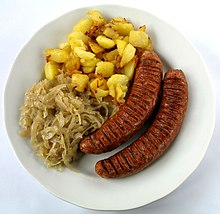Bratwurst

A bratwurst is composed of pork, beef, and sometimes veal. Etymology: German, from Old High German brAtwurst, from brAt meat without waste + wurst sausage. Popular etymology suggests "fried sausage"; this, however, is incorrect. The word bratwurst can refer to a sausage that is as yet uncooked (but meant to be cooked before eating), or already cooked by any means regardless of the word's origins. The word usually refers to a mostly pork product, but can be used to refer to an all beef product [1]. The word is also used for vegetarian sausages made of soy and seitan (wheat gluten).
The original German "Bratwurst" comes from Thuringia, known as Thüringer Rostbratwurst. Small bratwursts originate in Nuremberg, Germany; the more common longer, thicker form can be found almost anywhere else in Germany. A "Bratwurst" meal often is eaten with sauerkraut, mashed potatoes and roasted onions.
The sausage is usually eaten with a German mustard called "Senf" or sliced and eaten as Currywurst. Bratwurst is almost always served with a hard German roll known as a Brötchen and usually accompanied by a beer. It is a popular snack in German-speaking countries, where it is sold at various fast food outlets and is often consumed while standing.
In the United States, bratwurst are usually eaten with bread (a hot dog bun or a hardroll, for example) and topped with mustard and/or many of the other condiments often eaten with hot dogs, including onions (grilled and/or raw), relish, ketchup, sauerkraut, etc. The bratwurst is occasionally eaten with a pair of brat links nestled in a buttered hardroll with these same toppings, which is called a 'double brat'.
Within the US, bratwurst, while not strictly a regional cuisine, is strongly identified with Milwaukee, Wisconsin, and other areas in a band stretching from the north side of Chicago up through Minnesota and scattered pockets elsewhere in the Midwest.
They are especially popular in areas of the US where German-Americans settled in large numbers, like Sheboygan, Wisconsin, which is informally known as the Bratwurst Capital of the World because of the city and county's very strong German roots and connections to bratwurst. Johnsonville Foods, the nation's largest bratwurst maker, is based in the nearby unincorporated village of Johnsonville. The city also celebrates Sheboygan Bratwurst Days, a community festival held on the first Thursday-Saturday of August each year that celebrates the bratwurst. Other traditional Wisconsin brat manufacturers include Klement's Sausage Company and Usinger's, both of which are based in Milwaukee.
Another town with German-American roots associated with bratwurst is Bucyrus, Ohio, which is known for its unique recipe incorporating fennel. It holds a bratwurst festival annually in mid-August attracting over 100,000 visitors annually. [2]
Bratwurst(s) is/are often simply called brat(s).
